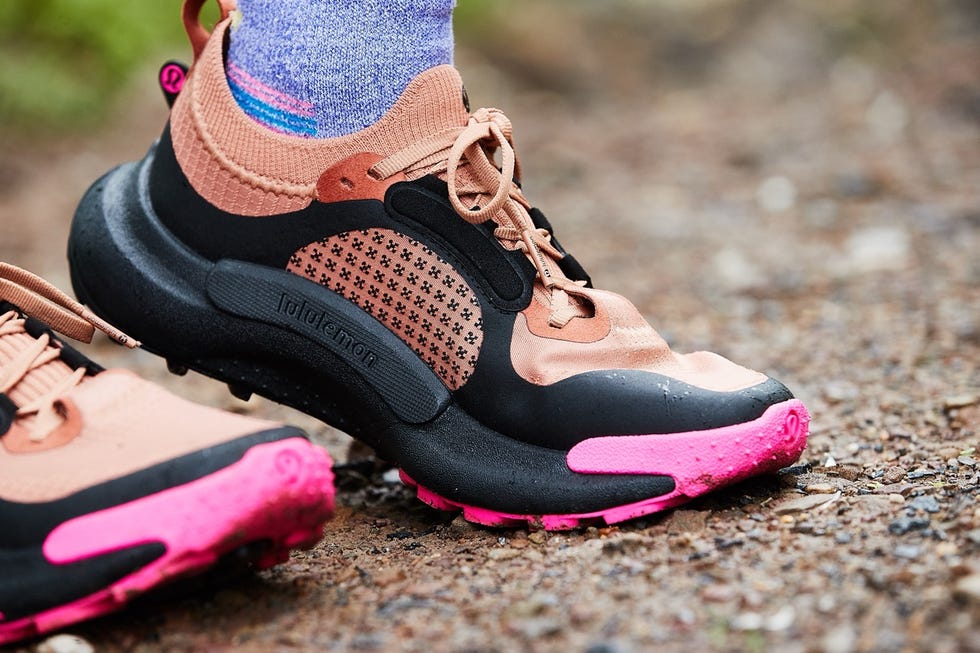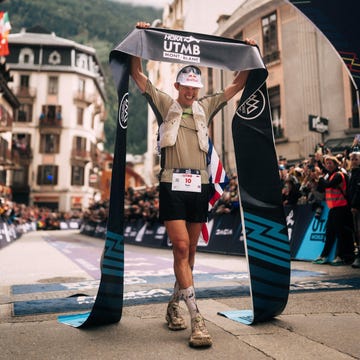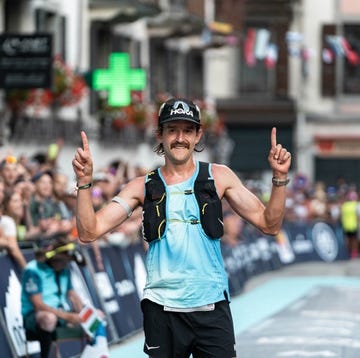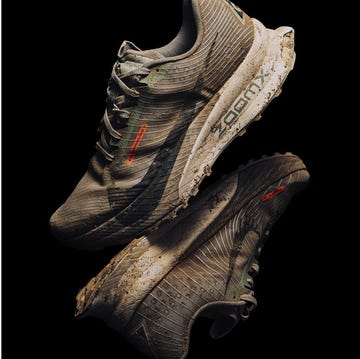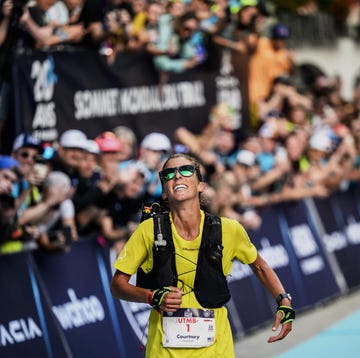- Weight: 334g (M's UK 8), 292g (W's UK 6.5)
- Drop: 7.5mm (M), 6mm (W)
- Lug height: 4mm
- For runners who like: Hoka Zinal, Brooks Divide, Nike Pegasus
- Why run in this shoe: A flexible, lightweight trail shoe that runs smooth off — and on — road, with a comfy fit catered to men’s and women’s bio-mechanical differences.
The Wildfeel, Lululemon’s newest trail shoe, follows the success of the Beyondfeel Trail. In the Beyondfeel Trail, runners experienced the best of both worlds: the supportive cushioning of the Beyondfeel road shoe in a model converted for gnarlier efforts. The Wildfeel, on the other hand, has no road shoe template. It’s built for the trail from the ground up, with a high-abrasion rubber outsole that has a grippy tread, and durable upper meant for blazing through thick underbrush. But that hasn’t stopped our testers from using the shoe as a road-and-trail hybrid.
Designed for trail running
The Wildfeel uses a dual-density supercritical foam midsole; the heel is cushier to absorb shock, while the firmer forefoot promotes a responsive toe-off. It also has a more scalloped midfoot shank compared to the Beyondfeel Trail.
‘The Wildfeel has a confident footprint’ said VP of footwear at Lululemon George Robusti, on a video call with Runner’s World. ‘We have wrapped the midsole on both sides up so you’ve got a more hug-and-hold without it being a guidance, or sort of overbearing, support.’
What everyone's reading
Fun textures and patterns signal a departure from the more utilitarian look of the brand’s previous models.
’We generally have a very thoughtful, sort of reductive aesthetic. That’s the kind of historical, visual language that’s run through much of the brand’s products since day one’ said Robusti. ‘The Wildfeel was actually a good invitation because trail, it’s more gear once it goes beyond footwear: there’s hardware, there’s abrasion, you’re interacting with physical objects in different ways that you don’t necessarily on a road. There was a chance to really lead through design, lead through functionality. But within that there was more componentry, and then more expression within that.’
Part of the componentry is Nulu lining, which houses your feet to provide a comfy fit. The lycra-nylon material is the same fabric used in the brand’s yoga tights. The soft rim of the sock-like collar keeps trail debris from getting inside the shoe. Because I drag my feet a lot on trail runs, I’m always fishing out tiny stones post-run. This wasn’t so with the Wildfeel; that collar dutifully served as a protective gaiter.
The outsole has 4mm lugs, which have an ascending/descending orientation for traction on uneven terrain. The rubber wraps up above the toe to serve as a buffer from rocks and roots.
Women-specific construction
Since dipping its toe into running footwear, Lululemon has strived to make its models gender-specific, fine-tuning the fit, cushioning, and geometry to cater to the anatomical and bio-mechanical differences between men and women runners.
‘Between the men’s and women’s, we have the different lasts based on all the foot morphology and data that we started our path with,’ said Robusti.
Back when we tested the original Blissfeel, Lululemon’s first running shoe, the development team shared how they applied women-specific geometry in constructing the model. They delved deep into how the centre of mass and balance are different and how this affects biomechanics.
The distribution of foam in the Wildfeel accommodates the difference in load zones and stress put on areas of the foot. The forefoot of the women’s shoe, for example, is slightly more flexible than the men’s to compliment the shorter toes, longer arch, and shorter instep typical of women’s feet.
The heel-to-toe drop is different between the men’s (7.5mm) and women’s (6mm) shoes because the forefoot sockliner is slightly thicker in the women’s shoe.
Tried and tested
Through my own testing, I knew the Wildfeel was a winner because of the relief my feet felt when I chose to run in the shoe on trail days. Testing cycles require equal time with all kinds of shoes, no matter how stiff, heavy, or uncomfortable they make you feel. You know a shoe has something special going on when your body isn’t already bracing itself for miles of discomfort before you even set foot outside. Putting on the Wildfeel is like a breath of fresh air.
Besides the effective gaiter and heel collar, what I also loved about running in the Wildfeel was its flexibility. I felt nimble on the trail and could charge fast without having to put in extra effort like I have to sometimes with heavier, more rigid trail shoes. Tester Jenny Stump had similar comments.
‘I loved the literal and physical flexibility of the Wildfeel,’ she said. ‘I am primarily a road runner. These felt comfortable enough that I could do some easy miles on the road as well as tackle some trails with uneven surfaces. All the trail shoes I have previously tried felt more stiff and had such a thick sole that I wouldn’t even want to warmup on the road with them. I like the the depth of the tread. It’s enough that I feel secure on slick and uneven surfaces but not too heavy or rigid that my foot isn’t able to flex in the shoe.’ Stump suggested the shoes are ideal for long runs and road/trail days.
For tester Ryan Werling, cushioning was the standout feature.
‘The Wildfeel is an amazing shoe!’ said Werling, who has an extreme heel strike. The cushioning is out of this world — best I have experienced in this testing program. I have tested a lot of trail shoes lately with a wide toebox and have started to prefer that design of shoe, so it was a good opportunity to test a standard toebox. The Wildfeel was essentially an extension of my feet and I love how snug the shoes are once you get them on and the lacing system is impressive.’
Werling tested the shoes at Hot Springs National Park in Arkansas, USA, and on some trails in Indiana. He was able to subject the Wildfeel to extreme hill testing with rocks, water, and grassy surfaces. He found the traction reliable on all these surfaces.
One thing Werling and a couple of other testers complained about was the heat management in the shoe and lack of drainage. ‘There was no air flowing in the shoe but the other positives overall negate the lack of breathability,’ said Werling.


